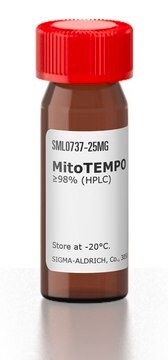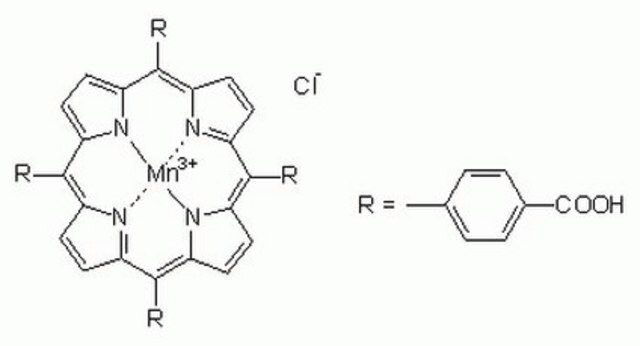推荐产品
品質等級
化驗
≥90% (HPLC)
形狀
powder
儲存條件
desiccated
顏色
brown to brown-red
溶解度
DMSO: 2 mg/mL, clear
儲存溫度
2-8°C
SMILES 字串
C[N+]1=CC=C(C=C1)C2=CC=[N+](C=C2)CCCCCCCCCC[P+](C3=CC=CC=C3)(C4=CC=CC=C4)C5=CC=CC=C5.[I-].[I-].[I-]
一般說明
MitoPQ (MitoParaquat) is a mitochondria-targeted redox cycler composed of the lipophilic triphenylphosphonium (TP) cation-conjugated paraquat that induces mitochondria superoxide production via redox cycling at the complex I flavin site. MitoPQ increases mitochondria superoxide production at a ~1000-fold higher efficacy than untargeted paraquat using either live cells (fold of change of MitoSox fluorescence = 1.4/1 μM & 3.2/5 μM MitoPQ vs 1.2/5 mM PQ; C2C12 myoblasts) or isolated mitochondria (fold of increase of H2O2 efflux = 4.6/1 μM MitoPQ vs 2.6/1 mM PQ; rat heart mitochondria). MitoPQ is a valuable tool for conducting cellular and in vivo investigations into the role of mitochondrial superoxide generation in redox biology. Additionally, it can be utilized as a catalyst or co-stressor to replicate metabolic and neurodegenerative disease traits in experimental models.
應用
MitoPQ has been used to enhance mitochondrial reactive oxygen species (mitoROS) production in T-cell culture and investigate its influence over T-cell differentiation.
儲存類別代碼
11 - Combustible Solids
水污染物質分類(WGK)
WGK 3
閃點(°F)
Not applicable
閃點(°C)
Not applicable
Ellen L Robb et al.
Free radical biology & medicine, 89, 883-894 (2015-10-11)
Superoxide is the proximal reactive oxygen species (ROS) produced by the mitochondrial respiratory chain and plays a major role in pathological oxidative stress and redox signaling. While there are tools to detect or decrease mitochondrial superoxide, none can rapidly and
Eva Sidlauskaite et al.
Redox biology, 16, 344-351 (2018-03-28)
Developmental synapse pruning refines burgeoning connectomes. The basic mechanisms of mitochondrial reactive oxygen species (ROS) production suggest they select inactive synapses for pruning: whether they do so is unknown. To begin to unravel whether mitochondrial ROS regulate pruning, we made
Elizabeth C Hinchy et al.
The Journal of biological chemistry, 293(44), 17208-17217 (2018-09-21)
Mitochondrial reactive oxygen species (ROS) production is a tightly regulated redox signal that transmits information from the organelle to the cell. Other mitochondrial signals, such as ATP, are sensed by enzymes, including the key metabolic sensor and regulator, AMP-activated protein
Reetta J Holmila et al.
Scientific reports, 8(1), 6635-6635 (2018-04-29)
Mitochondrial reactive oxygen species (ROS) are essential regulators of cellular signaling, metabolism and epigenetics underlying the pathophysiology of numerous diseases. Despite the critical function of redox regulation in mitochondria, currently there are limited methods available to monitor protein oxidation in
Maria M Shchepinova et al.
Cell chemical biology, 24(10), 1285-1298 (2017-09-12)
Mitochondrial superoxide (O2⋅-) underlies much oxidative damage and redox signaling. Fluorescent probes can detect O2⋅-, but are of limited applicability in vivo, while in cells their usefulness is constrained by side reactions and DNA intercalation. To overcome these limitations, we developed
我们的科学家团队拥有各种研究领域经验,包括生命科学、材料科学、化学合成、色谱、分析及许多其他领域.
联系技术服务部门








